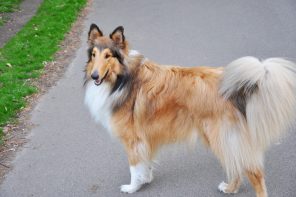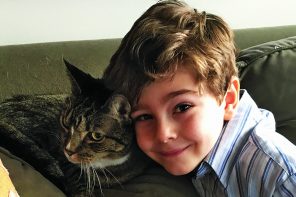After six days of goodbye events, including a dumpling party and heart-shaped ice cake feedings, the Chinese Ambassador to the United States, Cui Tiankai — along with Dennis W. Kelly, director of the Smithsonian’s National Zoo & Conservation Biology Institute in Washington D.C. — joined numerous fans Feb. 21 in bidding an emotional farewell to the beloved giant panda Bao Bao, the aptly named “Precious Treasure” who was born in the U.S. of parents on loan from China.
For the past three years, the adorable toddler has been the favorite attraction in the capital. But all good things must end and, per an agreement with China, panda offspring must return to their ancestral homeland to make more pandas.
“Today is bittersweet,” Kelly said. “We’ve watched Bao Bao grow up during the past three years and she has charmed people from all over the world with her independent and playful personality. This is another milestone in our 45-year history of research to care for and help save the giant panda and its native habitat.”
Ambassador Tiankai called Bao Bao the “second Chinese Ambassador,” and an envoy of China-U.S. friendship. “Because it is very difficult for giant pandas to breed naturally,” he said, “Chinese and Americans have been working on breeding them through artificial insemination.”
Her Excellency Bao Bao got the royal treatment all the way. She was coaxed into a padded, custom-made travelling crate and towed out of the panda enclosure by a forklift with panda ears and a tail. Her crate was finally elevated into the aircraft, a panda-decaled “FedEx Panda Express” 777, emblazoned with an image of a giant panda crunching bamboo. Precious Treasure was accompanied by a veterinarian and her keeper, Marty Dearie, along with 55 pounds of bamboo, two pounds of apples, two bags of leaf eater biscuits, two pounds of sweet potatoes, 10 gallons of water and some sugar cane. The flight crew members respectfully wore “FedEx Panda Team” T-shirts. Thus China’s national icon flew to her ancestral homeland to begin the next chapter of her life.
After a 16-hour nonstop flight from Washington, Bao Bao landed safely in Chengdu, in Suchuan province, and was transported to the China Conservation and Research Center for the Giant Panda’s Dujiangyan base in the adjoining mountains, where she will eventually join a breeding program. Curious Bao Bao emerged from her crate looking rather confused and was escorted into a luxurious 1,100-square-foot enclosure, with indoor and outdoor play areas offering rubber balls and tire swings. She was heartily welcomed by her new attendants and accepted a branch of bamboo. Panda expert Li Desheng in a news release said, “Once Bao Bao completes a month of quarantine… I will welcome everyone to see her.”
Every care was taken to make her feel at home. Her Smithsonian keeper, Dearie, will stay with Bao Bao until she adjusts to China. He will help her adapt to local bamboo and steamed bread made from corn, soybeans, rice and eggs. Since she only understands commands in English, he is taking Mandarin lessons.
Bao Bao is the 11th “overseas panda” to return to China. The Smithsonian’s first two pandas, Ling-Ling and Hsing-Hsing, were gifted by China’s Chairman Mao Zedong to the American people to commemorate President Richard Nixon’s trip to China in 1972. Since then, giant pandas have become China’s unofficial national mascot. Animal lovers are smitten by the furry black-and-white creatures with black eye-patches that resemble teddy bears.
Baby pandas cry like human infants. Nursing mothers gently caress their suckling infants with an agile forepaw. The giant panda is the only bearlike animal with a thumb like ours, which gives them a prehensile skill rivaling that of a primate. After severing a stalk of crisp umbrella bamboo with one mighty crunch, they use their thumbs to peel it open adroitly before licking it like a child savoring an ice cream cone.
Giant pandas seem to exude a spiritual power that enchants all who gaze on them. For centuries, the Chinese have held them in special esteem. Ancient emperors kept them as pets, believing they were endowed with mystical powers capable of warding off natural disasters and evil spirits. Their black-and-white patterns symbolize the two great Chinese forces of separation and unity that constitute and balance the universe, the yin and yang, black and white, dark and light, moon and sun, death and life. For centuries, peasants have considered them lucky charms or even divine and have refrained from killing the pandas that entered their fields or raided their beehives.
Unfortunately, this mystical appeal may not be enough to save them. The species has been at extreme risk of extinction because of poachers and human activity shrinking their habitat. For centuries the slow-moving pandas were hunted for their prized fur. Deforestation and pollution drove their numbers down.
But thanks to public awareness and ambassadors like Bao Bao, the giant panda was removed from the International Union for Conservation of Nature’s list of endangered species in September of last year. The Union cited the wild panda’s population jump from 1,596 in 2004 to 1,864 in 2014, an increase of 17 percent. However, the Chinese government warned that the panda’s status was still serious because its natural habitats have been splintered by human and natural causes. Bao Bao will join 200 other pandas that live in captivity in an effort to save the wild giant pandas. Pan Pan, the world’s oldest captive male panda, died at 31. He sired 132 offspring.
Bao Bao is gone, but the National Zoo still features her brother, Bei Bei, age 1, and their parents, Tian Tian and Mei Xiang. She will miss her family.
Just as we will miss her.




